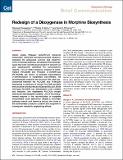Redesign of a Dioxygenase in Morphine Biosynthesis
Author(s)
Runguphan, Weerawat; Glenn, Weslee S.; O'Connor, Sarah Ellen
DownloadRunguphan-2012-Redesign of a Dioxyg.pdf (447.9Kb)
PUBLISHER_POLICY
Publisher Policy
Article is made available in accordance with the publisher's policy and may be subject to US copyright law. Please refer to the publisher's site for terms of use.
Terms of use
Metadata
Show full item recordAbstract
Opium poppy (Papaver somniferum) produces medicinally important benzylisoquinoline alkaloids, including the analgesics codeine and morphine, in the morphinan pathway. We aligned three dioxygenases that were recently discovered in P. somniferum and subsequently identified the nonconserved regions. Two of these enzymes, codeine O-demethylase (PsCODM) and thebaine O-demethylase (PsT6ODM), are known to facilitate regioselective O-demethylation in morphinan biosynthesis. We systematically swapped the residues that were nonconserved between the PsCODM and PsT6ODM sequences to generate 16 mutant PsCODM proteins that could be overexpressed in Escherichia coli. While wild-type PsCODM can demethylate both codeine and thebaine, one engineered PsCODM mutant selectively demethylates codeine. Use of this reengineered enzyme in the reconstitution of morphine biosynthesis could selectively disable a redundant pathway branch and therefore impact the yields of the downstream products codeine and morphine in subsequent metabolic engineering efforts.
Date issued
2012-06Department
Massachusetts Institute of Technology. Department of ChemistryJournal
Chemistry and Biology
Publisher
Elsevier
Citation
Runguphan, Weerawat, Weslee S. Glenn, and Sarah E. O’Connor. “Redesign of a Dioxygenase in Morphine Biosynthesis.” Chemistry & Biology 19, no. 6 (June 2012): 674–678. © 2012 Elsevier Ltd.
Version: Final published version
ISSN
10745521